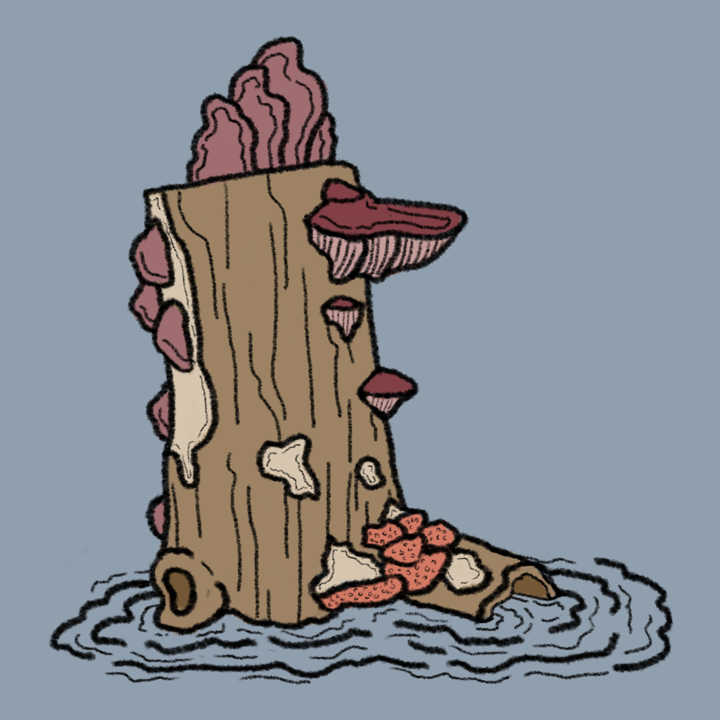Jorge Antonio Losoya

In Entangled Life: How Fungi Make Our Worlds, Change Our Minds and Shape Our Futures (2020), Sheldrake takes us into the world of fungi where planning scholars can expect refreshing perspectives from non-human organisms. Sheldrake’s storytelling proves to be a captivating lesson on fungal biology, detailing their intimate entanglements with the human world. Through each chapter, the author challenges us to think as fungi do. The book asks planning scholars to unsettle their human-centered concepts and engage with the more-than-human world. Entangled Life offers thoughtful insights through an exploration of fungi’s agency and resilient nature, which planners interested in social-environmental landscapes, placemaking, and interdisciplinary scholarship may find useful.
The author uses anecdotes from his time as a biologist to illustrate the ways fungi affect our thinking, feelings, and behavior. In the first chapter, he uses truffle hunting to frame fungi as active beings who interpret their environments, explaining how smell links the human world to the fungal one. Chapter 4 investigates psilocybin testing and fungi’s influence on the human and non–human mind. Some of the transformative and grassroots movements are explored in Chapter 7 through the author’s experience with radical mycologists. Each story mixes biological explanations with lessons for understanding our world.
Sheldrake’s telling of the dynamics of truffle hunting establishes fungi as agents of the landscape who utilize the lure of smell to influence animal and human behaviors in the hills of Bologna, Italy. In describing the sophisticated behaviors of fungi, Sheldrake asks us to rethink our attitude toward non-human organisms. Here Sheldrake poses an important question to readers that may lead us to broaden who we plan for and with:
Might we be able to expand some of our concepts, such that speaking might not always require a mouth, hearing might not always require ears, and interpreting might not always require a nervous system? (p.42)
With this question in mind, how can planners shift their thinking away from human-centered perspectives of the landscape they shape? What are other ways of participation? If planners are to grapple with fungi as collaborators, what could they learn from fungi? For Sheldrake, the possibilities of collaborating with fungi allow planners to imagine new meaningful ways to engage with the human and non-human world. Entangled Life thus asks planners to stretch their concepts and disciplinary boundaries to visualize a more complete and entangled space that includes both human and non–human participants.
In Chapter 2, Sheldrake introduces mycelium, which he describes as “a map of a fungus’s recent history and is a helpful reminder that all life – forms are in fact processes not things” (p. 53). Mycelium is further explored in chapters 5 and 6 where he describes its role in brokering relationships in ecosystems. For planners, then, mycelium may offer ways to conceptualize communities’ placemaking activities. For example, when considering the possibility of mycelium retaining a sense of memory (p. 47), one may then imagine a community’s mycelium as a hidden network inscribing memory on the landscape. Mycelium thus reminds planners that belonging is rooted deeply in the landscape, memory, and more–than–human relationships. And that community is a process, not a thing.
Sheldrake makes fungi’s persistence incredibly clear in Chapter 3 when he describes the extremophile lives of lichens and in Chapter 5 which details fungi’s long existence on Earth. What then can planners learn about this resiliency and persistence from fungi? They can learn from fungi’s restorative power in ecosystem remediation (p. 185) or from the fungal ability to catalyze radical transformation and partnerships from the ground up (p. 186). Planners may also learn from fungi’s capacity to thrive in disturbed landscapes, like truffles (p. 43) or matsutake (Tsing, 2015). As flexible, and collaborative organisms, fungi challenge planners to foster synergetic relationships across species and disciplines to imagine extravagant futures detached from systems of oppression.
While Sheldrake is not the first to recount our entanglements with fungi (Tsing, 2015; Hathaway, 2022), his book is a well-crafted introduction for planners unfamiliar with these curious organisms. Although imaginative, the author is also cautious in his arguments, reminding readers of the dangers of anthropomorphizing and romanticizing more-than-human relationships (p. 210). Readers should not expect grand solutions to planning challenges from the lives of fungi but instead, be led to sprouting new questions whose solutions lie outside their boundaries.
Entangled Life is a thought-provoking book for planning scholars interested in discussions on knowledge production, queer ecology, and non-human agency. Planners who want to understand the more-than-human relationships in the spaces they engage with or those looking for new metaphors for understanding the world should read Entangled Life. I recommend this reading for planners eager to wander beyond traditional planning limits to spaces that allow them to unmake and recreate new worlds as fungi do.
Book Citation
Sheldrake, M. (2020). Entangled life: how fungi make our worlds, change our minds & shape our futures. Random House.
References
Hathaway, M. J. (2022). What a Mushroom Lives For: Matsutake and the Worlds They Make. Princeton University Press.
Tsing, A. L. (2015). The Mushroom at the End of the World. Princeton University Press.
About the Author:
Jorge Antonio Losoya was born and raised in Del Rio, Texas along the Texas – Mexico border. He holds a M.S. in Community and Regional Planning and M.A. in Latin American Studies from the University of Texas at Austin. He currently works in state – led disaster recovery planning. His research interests surround disaster recovery, hazard mitigation, emotional landscapes, Latinx geographies, and artistic methodologies.
